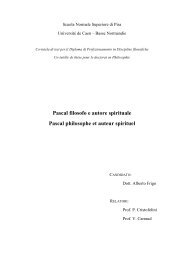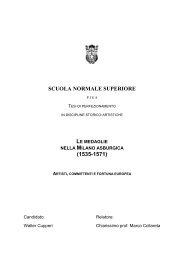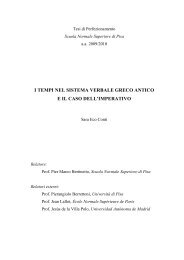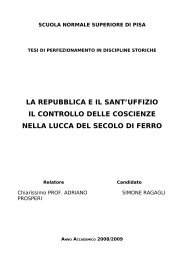CATULLUS 68 - Scuola Normale Superiore
CATULLUS 68 - Scuola Normale Superiore
CATULLUS 68 - Scuola Normale Superiore
You also want an ePaper? Increase the reach of your titles
YUMPU automatically turns print PDFs into web optimized ePapers that Google loves.
innovation, as quisquis is found in all other MSS) and Liv. 41.8.10 liberos suos quibusquibus Romanis ...<br />
mancipio dabant (thus the MSS: quibusuis Weissenborn, quibuslibet Novák). This may also be the correct<br />
reading at Q. Cic. pet. 17 ut quisquis est intimus ac maxime domesticus (quisquis codd. HVB: quisque FD).<br />
de meliore nota nota must have been used for the titulus, the label indicating the type of wine inside the<br />
cask or amphora. It is is attested for the type or vintage of wine (thus at Cic. Brut. 287 ut si quis Falerno uino<br />
delectetur, sed eo nec ita nouo ut proximis consulibus natum uelit, nec rursus ita uetere ut Opimium aut<br />
Anicium consulem quaerat – atqui hae notae sunt optumae; also Hor. Od. 2.3.8 interiore nota Falerni and<br />
Sat. 1.10.24 Chio nota si commixta Falerni est), and hence in a somewhat informal metaphor also for the<br />
quality of things other than wine: note Ov. Am. 2.5. uolo non ex hac illa fuisse nota (of kisses), Col. 3.2.19<br />
secundae notae uites, Petr. 116.5 urbanioris notae homines, Sen. Ep. 15.3 pessimae notae mancipia and Ben.<br />
3.9.1 quaedam [i.e. beneficia] non sunt ex hac uulgari nota, and see further OLD s.v. nota, 5b-c. The set<br />
phrase de meliore nota, ‘of a better label’, is also used by Curius ap. Cic. Fam. 7.29.1 Sulpici successori nos<br />
de meliore nota commenda.<br />
29 This is a so-called ‘golden line’, a hexameter consisting of two adjectives and two nouns with a verb<br />
placed in the middle, where the first adjective agrees with the first noun and the second adjective with the<br />
second noun in the pattern A 1 A 2 V N 1 N 2 . A similar line in which the adjectives and nouns correspond to<br />
each other in reverse order in the pattern A 1 A 2 V N 2 N 1 is known as the ‘silver line’: compare e.g. Cat.<br />
64.314 libratum tereti uersabat turbine fusum. These two types of hexameter are absent from Greek poetry<br />
(where they would have been harder to realize than in Latin, which has freer word-order, no definite article<br />
and longer words than Greek). In Latin silver lines are found first in the young Cicero’s Aratea (in frg. 32<br />
Buescu at line 111 aestiferos ualidis erumpit flatibus ignes and line 438 extremas medio contingens corpore<br />
terras), while golden lines first appear in Lucretius (note 3.345 mutua uitalis discunt contagia motus) and in<br />
Catullus, who markedly prefers the golden line (also at 64.59, 129, 163, 172, 235, 264 and 351 and at 66.13)<br />
to the silver one (at 64.314, 321 and 3<strong>68</strong>). It is hard to tell exactly what consists a golden or silver line and<br />
what does not, and surveys such as this one are only approximative: here I treat participles as verbs, but<br />
exclude lines that contain an article or another short word alongside the standard ingredients. It may not be<br />
important to arrive at an exact definition, as neither the name or the definition of the golden and the silver<br />
line go back to antiquity, and poets appear to have written lines of this type not because they were trying to<br />
do so, but because it resulted from a particular style of composition. If one lets most nouns be accompanied<br />
by an adjective, often puts the verb in the middle of the hexameter, and often separates the adjectives from<br />
the nouns which they qualify, then one is bound to end up writing verses of this type, alongside many<br />
variants: this is the case for example in Catullus 64. This style of composition seems to have been developed<br />
by Latin poets in the 1 st century B.C. under the influence of Alexandrian poets such as Euphorion and<br />
Hermesianax who resorted to similar, albeit less elaborate, patterns of word order. On the golden and the<br />
silver line see further Conrad (1965: 234-241).<br />
138






